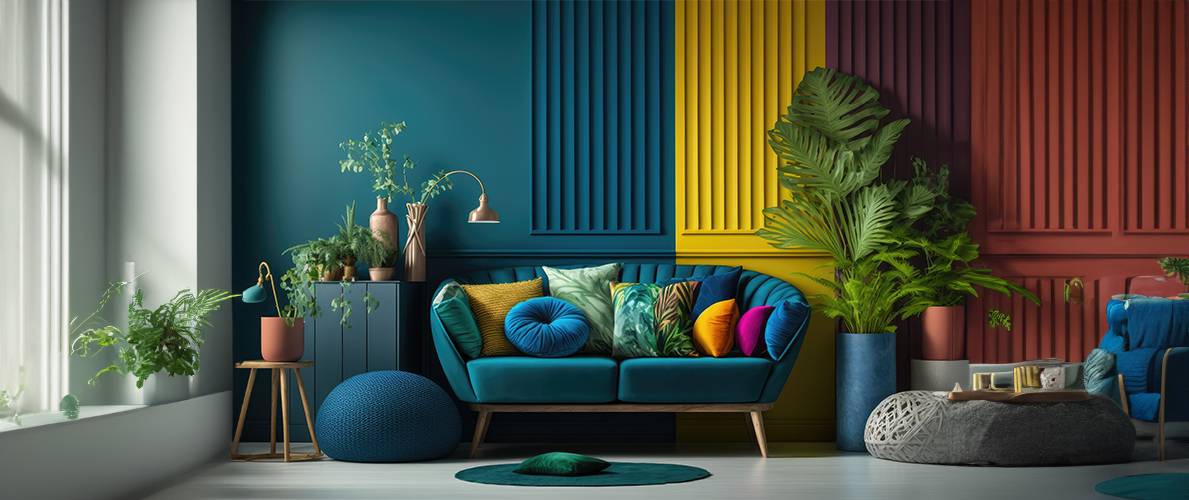Get expert miami interior design for high-end home and office interiors.
Get expert miami interior design for high-end home and office interiors.
Blog Article
Transform Your Home With Important Principles of Inside Design and Aesthetic Appeals
By recognizing the influence of color theory and the significance of appearance and patterns, one can produce areas that are not only visually appealing yet additionally deeply personal. Achieving this balance entails even more than mere decoration; it incorporates a critical plan and a keen understanding of just how each aspect communicates within a room.
Comprehending Shade Theory
Shade theory is a fundamental facet of interior decoration that dramatically affects mood, assumption, and overall visual. Comprehending the concepts of color theory enables designers to produce spaces that reverberate emotionally with owners while satisfying functional demands (interior design firms). Shades can be categorized into three key types: main, secondary, and tertiary. Each classification plays a crucial duty in establishing consistency within a room.
The psychological effect of shades is extensive; warm hues such as reds and oranges evoke power and warmth, while amazing tones like blues and environment-friendlies promote calmness and harmony. The use of complementary colors enhances aesthetic interest, producing striking contrasts that can raise a space's charm.
Neutral shades, on the various other hand, work as a versatile backdrop, enabling other style aspects to radiate. It is vital to consider elements such as lighting and the room's purpose when selecting a color palette, as these can alter the perception of colors throughout the day.
Ultimately, a well-considered color scheme can transform a space, fostering a feeling of convenience and design that lines up with the occupants' choices. Proficiency of color theory is, for that reason, an important skill for any interior developer intending to produce harmonious and inviting settings.
Achieving Equilibrium in Layout
How can developers achieve a feeling of balance in their spaces? Accomplishing balance in design is basic to creating unified interiors.
Unbalanced balance, on the various other hand, depends on varying elements that still attain a natural look. This technique enables more vibrant and informal setups, offering passion while preserving balance. By thoroughly picking varying dimensions, colors, and structures, designers can produce a visually compelling area that really feels well balanced yet energised.
Radial balance stresses a central centerpiece with components radiating external. This style is frequently seen in round layouts, where furniture and design develop a cohesive surround that draws the eye internal.
Ultimately, achieving balance needs thoughtful factor to consider of scale, proportion, and the connections in between components. Architecture Firm. By skillfully applying these balance principles, designers can transform areas into settings that really feel both cosmetically pleasing and functionally unified, enhancing the overall experience for residents
Importance of Spatial Understanding
:max_bytes(150000):strip_icc()/GettyImages-1161177015-f1de4ba58a6c4f50969d9119d80405a6.jpg)
An eager feeling of spatial recognition allows developers to recognize focal factors within an area, guiding the audience's interest to vital features while preserving a general feeling of unity. It likewise assists in the critical positioning of lighting, which can substantially influence the understanding of space and state of mind. Recognizing spatial relationships enables the developer to provide to the certain requirements of residents, guaranteeing that each location offers its designated purpose without compromising aesthetics.
Inevitably, this post spatial recognition is vital for making best use of the possibility of any type of interior room. By meticulously thinking about the interplay between dimensions, format, and function, designers can develop atmospheres that not just satisfy practical needs however also stimulate here a sense of convenience and charm, improving the overall living experience.
Including Structure and Patterns
Welcoming a varied series of appearances and patterns can considerably improve the aesthetic and tactile allure of an indoor space. The calculated use different materials-- such as timber, steel, material, and rock-- produces deepness and passion, making a room really feel more welcoming and vibrant. Incorporating smooth surfaces with rough textures can establish a balance that draws the eye and involves the senses.
When incorporating patterns, take into consideration both scale and repeating. Huge patterns can function as focal points, while smaller sized, refined designs can match various other elements without overwhelming the space. Layering patterns, such as pairing floral paddings with candy striped throws, adds intricacy and a feeling of consistency if implemented thoughtfully.
It is likewise vital to preserve a natural color palette, ensuring that textures and patterns interact as opposed to complete for focus. By selecting a few key appearances and patterns, you can develop a linked visual that shows your personal design while boosting the general atmosphere of the room. Ultimately, the careful unification of these aspects can transform a mundane room right into an advanced environment abundant with personality and heat.
Individualizing Your Area
Creating a this content room that shows your character is vital to achieving an absolutely welcoming atmosphere. Personalization in indoor style allows you to instill your one-of-a-kind design and interests right into your home, transforming it from a mere sanctuary into a shelter that talks to that you are. Begin by choosing a color combination that resonates with your feelings-- vibrant tones can stimulate, while soft tones offer peace.
Integrate art work and design that mirror your passions, whether it be traveling, nature, or abstract concepts. Presenting personal collections, such as publications, photographs, or keepsakes, can evoke cherished memories and develop prime focus within an area. Additionally, take into consideration customizing practical pieces, like upholstered furnishings, to straighten with your aesthetic choices.

Verdict
In conclusion, the makeover of a home through the crucial principles of interior decoration and aesthetic appeal demands an extensive understanding of shade concept, equilibrium, spatial awareness, appearance, and customization. Each component contributes considerably to producing an unified and useful living atmosphere - interior design firms. By attentively incorporating these concepts, people can enhance the visual appeal and emotional resonance of their rooms, ultimately cultivating a home that shows distinct identities while offering comfort and practicality
Report this page